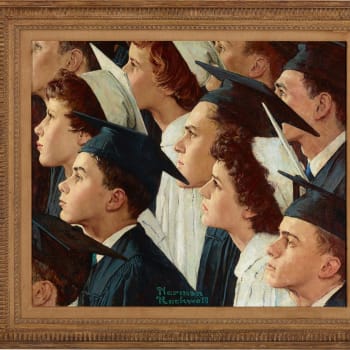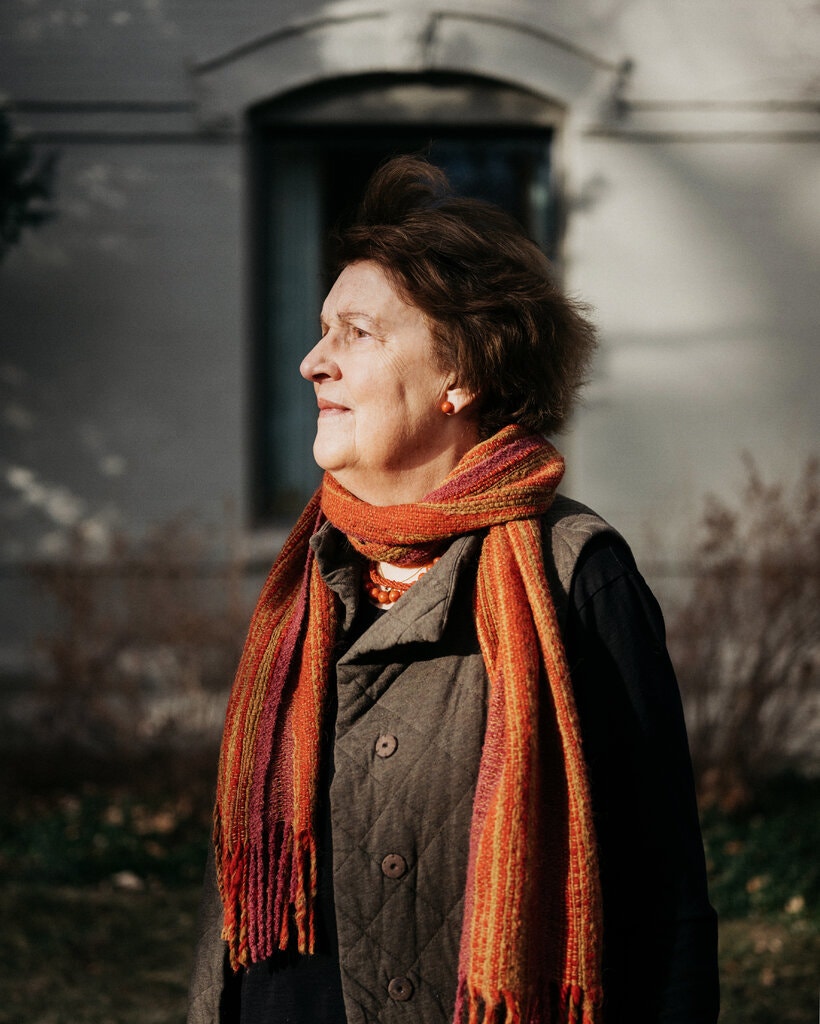
A Model and Her Norman Rockwell Meet Again
The Original Press Appeared in The New York Times. Click Here to View
By James Barron | March 9, 2021
Charlotte Sorenson was riffling through a newspaper one morning in December when she recognized someone in a gallery advertisement for a Norman Rockwell painting that she had not seen in years: herself.
There she was, a teenager in a cluster of schoolmates in graduation-day caps and gowns. Rockwell had called the painting “Bright Future for Banking.”
Sorenson, who is 81 and lives in Boulder, Colo., had posed for Rockwell when she was a 15-year-old high school sophomore in Stockbridge, Mass., the picture-postcard town in the Berkshires where he lived and worked from 1953 until his death in 1978. As the star illustrator for The Saturday Evening Post, he was known for summoning his neighbors to his studio to be models — dozens over the years. They were the faces in the quintessentially American images that the public loved but critics disdained. Sometimes he supplied the accessories at his easel, long after his subjects had left his studio. But for “Bright Future,” Sorenson said, he had a cap and gown at the ready, even though he did not tell her what the painting would be about.

Unlike famous Rockwell paintings like “The Problem We All Live With,” with its civil rights theme, or “The Runaway,” showing a police officer sitting at a lunch counter with a little boy who had run away from home, “Bright Future” had an unusual history. It was almost thrown out in the trash. The gallery owner selling the painting said it had been salvaged by a man walking down a Manhattan street a few years after it had appeared in the magazine with which Rockwell was closely identified for nearly 50 years.
The story he said they had told sounded like a scene from a Rockwell painting: Their father, walking along a street in Manhattan, had watched as a janitor from an office building heaved trash containers toward the curb. The men’s father spotted the painting and asked if he could have it.
The original work, signed by Rockwell, ended up on the wall in the older son’s bedroom, Rau said. While Rau would not say how much he had paid for the painting, he said that the two sons had put it up for sale because neither son would buy the other’s share. Rau’s price for it is $885,000.
Rockwell’s paintings have climbed in value in the 2000s. “Saying Grace” (1951) sold for $46 million at Sotheby’s in 2013, more than double the presale estimate. That topped “Breaking Home Ties,” which had sold for $15.4 million at Sotheby’s in 2006. “The Gossips,” a montage of friends, neighbors and Rockwell himself, went for $8.45 million at the 2013 auction with “Saying Grace.” More recently, in 2017, Rockwell’s “Two Plumbers” brought $1.9 million.
The people he painted were real, though. Like Sorenson in “Bright Future,” many lived in or near Stockbridge. William J. Obanhein, the police chief in Stockbridge, posed for Rockwell several times (though he was better known as “Officer Obie” in Arlo Guthrie’s Vietnam-era ballad “Alice’s Restaurant Massacree” because he had arrested Guthrie for littering).
“People who were Rockwell’s models have a sense of a little bit of celebrity,” said Stephanie Plunkett, the deputy director and chief curator of the Norman Rockwell Museum in that town. “Some of them, especially if they were children, didn’t recognize what was being asked of them. It wasn’t until they were adults that they realized that what they had done was so interesting and important.”
That applied to Sorenson.
“It was quite common to be sitting somewhere or walking somewhere, and he would spot you,” she said, “and in his mind he had some painting that he was thinking of, so he would ask you or send somebody to ask if you would come up to his studio.”
Rockwell’s studio on Main Street had a plate-glass window and was nicely situated for people-watching. Sorenson remembers that it was across the street from one important local hub, the drugstore, and next to another, the Western Union office.
“He thought of himself as a movie director casting a role,” Plunkett said. “He would sometimes test four or five people for one role in a painting. What that really meant was eventually one would be chosen and the rest would be on the cutting-room floor, so to speak, though he would sometimes use different components of each person. He might actually use a different face on a different body.”
Sorenson believes that the request from Rockwell came in 1954, when she was in the 10th grade at the Stockbridge Plains School. After classes let out for the day, she said, “the fun thing was to walk down the street and go to the drugstore. You’d go in and you’d either sit in a booth and order a root beer float or sit on a stool at the counter on one of those wonderful stools that twirled around.”
She does not remember whom Rockwell sent to invite her to go across the street to his studio. Nor does she remember much about the modeling session. “He must have put that hat on my head and taken pictures,” she said. “And then I probably went back to twirling on the stool in the drugstore and sipping on my root beer float and I didn’t think anything more of it.”
Plunkett, of the Rockwell museum, filled in some details about his encounters with potential subjects. “He had a studio assistant taking the actual photographs,” she said. “He brought each person into the studio individually. He would very succinctly explain to them what the piece was and what kind of expression he was looking for. He would be right there coaching them. When he got the expression he wanted, he would tell the photographer to take the shot.”
She said he gave his models a Coca-Cola and paid them, typically $5 to $10 for a session that lasted about 20 minutes. “Many of them say, ‘I wish I hadn’t cashed the check,’” she said. That fee was more than Rockwell’s son Peter, who died last year at 83, said he had received. “I got paid $1 an hour, and people outside the family got $5, which I thought was terribly unfair,” he said in 1993.
Rockwell painted more than 300 covers for The Saturday Evening Post. But “Bright Future” was painted for an advertisement for a bank (although it appeared in the magazine, in 1955). “He used more female models and female subjects in advertisements, which tended to represent a wider cross-section of America — the Saturday Evening Post covers tended to be more male,” said Deborah Solomon, an occasional Times contributor and the author of “American Mirror: The Life and Art of Norman Rockwell” (2013). “It was in the commercial interests of most companies to include images of women in their advertisements, which explains why Rockwell’s most vivid images of girlhood and womanhood are probably those that he drew for advertisements for Crest toothpaste, Kellogg’s Corn Flakes and Massachusetts Mutual Life Insurance.”
Sorenson said she posed alone, but in the painting, she was flanked by schoolmates — a girl who was nicknamed “Carrots” because of her red hair and two boys named Norman. But she felt a sense of disappointment when she saw the painting in The Saturday Evening Post — not on the cover, but inside, in the bank ad.
“It wasn’t one of his major exciting pictures like the runaway with the cop,” she said. “I was never that excited by it. I think it’s kind of boring.”
James Barron is a Metro reporter and columnist. He is the author of the books “Piano: The Making of a Steinway Concert Grand” and “The One-Cent Magenta” and the editor of “The New York Times Book of New York.”

